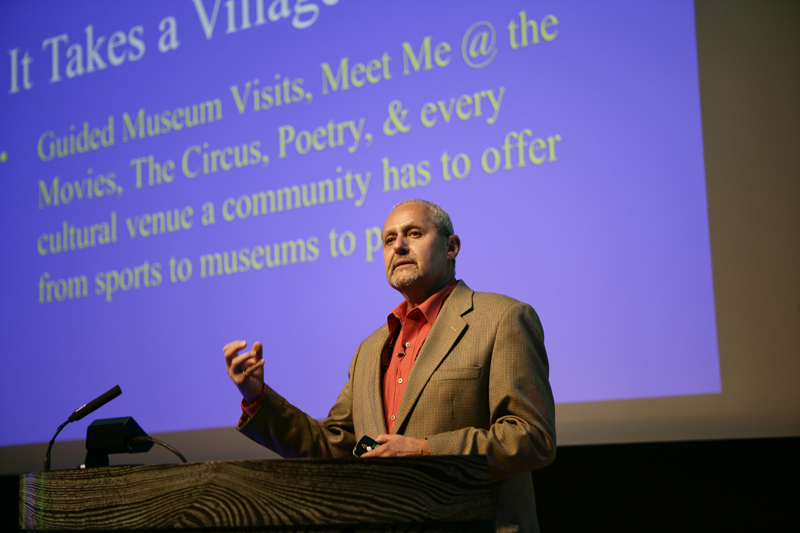There is a choice to be made in the new paradigm of healthcare and design: do we choose to build a system that encourages despair or do we design one founded on hope?
President and founder of Hearthstone Alzheimer Care and the I’m Still Here Foundation, John Zeisel presented these two contrasting models as part of his keynote address at the European Healthcare Design Congress last week. 
Speaking on the topic of ‘Hopeful ageing: the power of the arts and design to contribute to a life worth living’, he told delegates that people are, in general, more afraid of getting dementia than cancer. The fear of losing a part of the self, as well as relationships with loved ones, is embodied in a wider healthcare system built on fear, which also leads to increased costs and stigma.
“Most of us don’t rely on memory all the time, said Zeisel. “Quality of life is much more important.”
Citing the influence of Marshall Ganz, a Harvard University professor, Zeisel described the despair model as one where a diagnosis of dementia, and the negativity attached to it, creates a downward spiral. The result is greater sadness and loneliness, and an environment in which the four ‘A’s of anxiety, agitation, aggression and apathy tend to flourish, causing relationships to fracture and wane.
The hope model, by contrast, says “let’s stay in the present, let’s be sad and grieve that there’s a chronic illness, but let’s see the person and not let the illness dominate who we are and what we do,” explained Zeisel. If we continue to do things together, he continued, there’s less loneliness, the four ‘A’s don’t take place, and there’s better relationships and, consequently, a stronger definition of the self.
“It’s important that we’re not hoping for something that is impossible; we’re hoping for something that we can make a difference in,” he said. “As designers, in everything, in the broadest sense, you can make a difference (YCMAD), so YCMAD is the definition of hope.”
Dementia care, he explained, is defined as “a care partner, who provides care for the individual, and they receive burden. The longer the period over which this takes place, the more burden develops. Even respite programmes, they just interrupt the burden and there is inevitable burnout.”
The solution is to focus on quality of life and create true community support. The ‘It Takes a Village’ model is a hub and spoke community care model for dementia. At the centre is a hub called the Artz Hub, where people are brought together and where there may be education or arts exhibits. The spokes are programmes, which are supported by three types of partner: the cultural partner – those who provide the museums, the cafes and the parks; the community partners – those who use these facilities and places; and, finally, the research and evaluation arm.
Taking place in local cinemas in the US, ‘Meet Me at the Movies’ is just one example of a community programme and ‘hopeful’ treatment method. People with memory loss are shown five-minute clips of iconic films. Afterwards, they are asked to discuss their experiences, with the clips used as a vehicle to share and reminisce about their own lives.
The model is based on the fact that people have two learning systems, explained Zeisel. “One is called the episodic learning system, where we learn facts. Procedurally is the way we learn to ride bicycles, write our signatures, play golf, etc. People with dementia never lose the ability to learn procedurally. Hence, if you have a programme in a public space, every week, the same day and the same time of day, over and over again, by the fourth or fifth week everyone says, for example, ‘well, where are we going? It’s Thursday’.
“So the learning is not of the place or the event, the learning is of the process, and the fact that the community is open to them. It’s a human right for all of us to participate in our community.”
Every place in the city can be part of the ‘It takes a village’ model, whether it be a private, public, or governmental space. This universal approach is important, said Zeisel, in order to overcome what he describes as the “threshold problem”; that is, people are afraid to leave their home, care staff are afraid to go out with people outside of the care homes, people are afraid to remove themselves from the familiar long-term care setting because of stigma, and because that threshold represents their safety belt.
The hope model, described by Zeisel, could become more important in the future for other reasons, too, as Zeisel foresees a move away from substitute decision-making in favour of supportive decision-making.
“We are all going to have to find ways to help people with dementia – and everybody as they age – make choices to fulfil their own human needs in whatever way possible,” he said.
Design and the arts will therefore take on increasingly important roles, he concluded, as they can help the city open up new opportunities for dementia care, while breaking down the barriers between healthcare settings and other forms of space – all in order to “provide everyone with a life worth living, no matter what their condition”.

